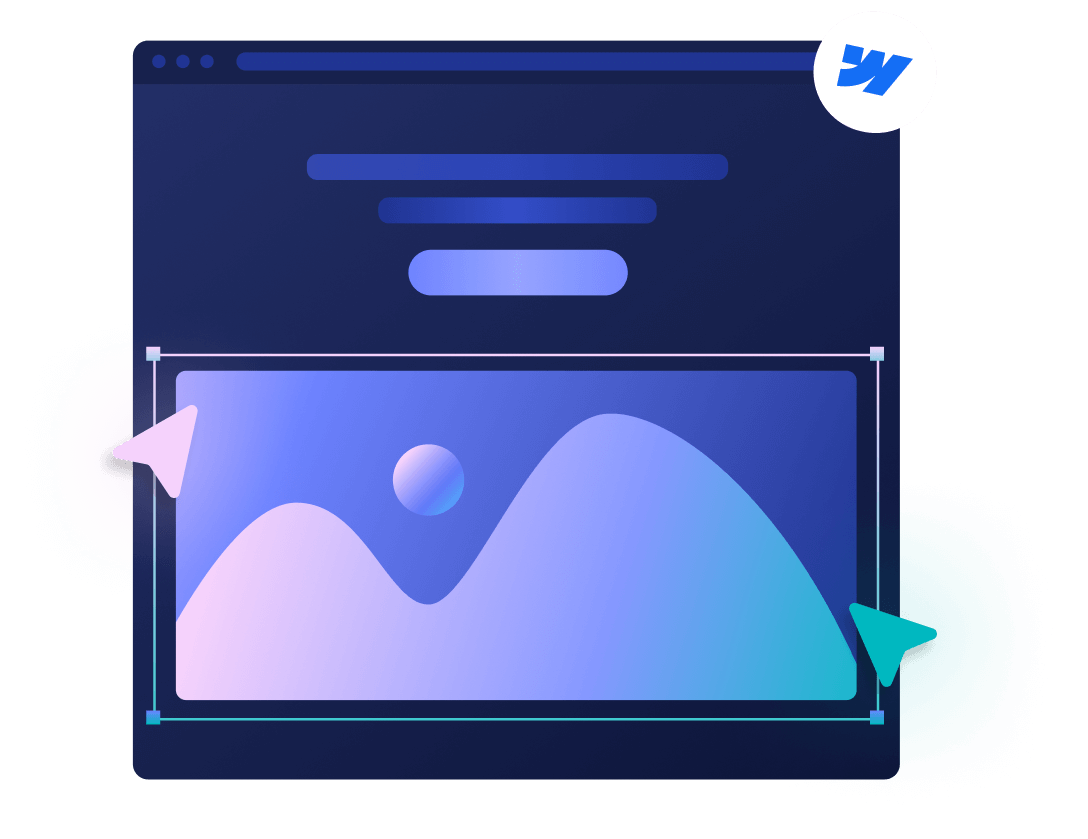-min.png)
Why Marketing-Led Teams Prefer Webflow for Faster Website Launches
Key takeaways
- Webflow empowers marketing teams to build and launch websites quickly without heavy developer reliance.
- Marketing-led websites prioritize growth, conversions, and data-driven decision-making across the entire funnel.
- Traditional development slows teams with long timelines and constant engineering dependencies.
- Webflow’s no-code builder, CMS, components, and integrated hosting enable fast, scalable site launches.
- Collaboration features and reusable libraries streamline teamwork across design, content, and development.
- Faster launches allow rapid experimentation, higher conversions, and stronger ROI for marketing campaigns.
Webflow is a robust website experience platform designed for a wide range of users, from entrepreneurs and small teams to large and enterprise-level companies. Designers love it for its detail-oriented approach, and it's often used by sites that need flexible CMSs and fast scaling times.
However, is Webflow for marketing teams? Does it allow them to build complex websites quickly and efficiently? The short answer is a resounding yes, but there’s so much more to it that both small and large marketing teams should know, especially when it comes to what exactly Webflow offers and the key features it has that make a fast website launch possible.
{{cta}}
What Is a Marketing-Led Website Approach
A marketing-led website approach is essentially a strategy for running a website, where the primary driving factors of the site’s design, functionality, content, and purpose are aligned with the marketing objectives your business has.
The approach focuses on growth, attracting more potential buyers, nurturing leads, and ultimately converting as many as possible into loyal, paying customers.
So, instead of being a static information hub, the website becomes a central and dynamic instrument for meeting specific marketing goals.
Besides becoming goal-oriented, a marketing-led website becomes centered on understanding the target audience and creating high-quality content.
The marketing teams behind it are focused on increasing conversion rates and making decisions based on measured and analyzed data. Most of all, the website is connected to all other marketing efforts and serves as the central hub for them.
The Limitations of Traditional Website Development
Traditional website development relies heavily on manual coding, which has numerous limitations in today’s market. Up-front costs are high, there’s not enough flexibility with what you can do, and the design and performance can be very subjective. However, the biggest limitations are slow launch timelines, and you rely heavily on the engineering teams.
Slow Launch Timelines
When building a site with Webflow, the code is written automatically as you use the visual builder. In contrast, with a traditional method, the code must be written from scratch.
This is a lengthy process that involves detailed planning, design, coding, and testing. On top of that, you’ll likely need to do at least a few revisions, which further extends the time.
This leads to slow launch timelines, which can be 3 to 5 months away, while more complex sites can take more than an entire year to build.
Heavy Dependency on Engineering Teams
Building a website from scratch requires constant help from engineering teams. You need an entire team of developers during the process.
What’s worse, you need one or more skilled developers even after the launch, since only a skilled professional will be able to make even minor updates, design tweaks, and content changes.
Problems like these will severely limit marketing initiatives and create bottlenecks.
Why Webflow Aligns With Marketing Team Needs
By using Webflow instead of the traditional approach, marketers can look forward to being less reliant on developers, while launching full sites or landing pages becomes much faster. Webflow makes it easier to keep creative control and design control as it allows for no-code visual development. It also offers free Webflow site plans, so up-front costs can be lower.
No-Code Visual Development
Building websites or apps with Webflow is done through visual development, which we cover extensively in our detailed Webflow review. It offers a sophisticated visual canvas that effectively translates into clean semantic code automatically.
You get to move elements around and customize them, apply various styles, and set up interactions through an interface, not by writing code.
What’s more, while you’re building, you get immediate visual feedback so you know exactly how everything looks and whether it works well.
Faster Iteration and Launch Cycles
The digital marketing world today is very agile and evolving rapidly. That’s why it’s essential to be able to launch a website quickly, and that’s precisely what you get to do with Webflow. It makes the process fast through:
- Quick prototyping: You get to build interactive prototypes directly in Webflow without having to develop static mockups first.
- Rapid landing page launch: You can launch various landing pages or updates within hours.
- Library of reusable elements: Once you design a component like a button or testimonial, you can easily reuse it from the Webflow templates library.
Control Over Content and Design
Using a traditional method, you can’t even make content changes on your site without outside assistance. Webflow makes it incredibly easy to make design and content changes, even if you’ve had help building the website.
You gain granular control over design, with near pixel-perfect control over every visual aspect. Furthermore, you can easily create custom interactive elements.
The Editor tool that Webflow offers makes it simpler to change content quickly, whether editing text or changing images. Furthermore, with Webflow CMS, you can create collections of content that you plan to reuse, allowing you to manage a large amount of dynamic content with ease.
Key Features That Enable Speed and Flexibility
Webflow offers a lot of features, and I’ve already told you briefly about some of them. Several of them, like the CMS, Components, and built-in hosting, are mainly responsible for Webflow offering greater speed, efficiency, and flexibility.
Webflow CMS and Component Libraries
Webflow CMS and the Component Libraries are two highly interconnected features that enable users to develop and run dynamic, highly scalable websites.
The CMS is a flexible service designed to enable you to use dynamic content efficiently. It lets you create customized Collections (databases for storing content) for any type of content you’re looking to create, like blog posts, products, and case studies. The CMS also features built-in SEO elements that let you optimize your site.
As for the Component Libraries, the feature allows you to create building blocks for your site, such as buttons and sliders, store them, and then reuse them as needed, just as I mentioned before. However, what I didn’t tell you is that you can also share these libraries, which is a lifesaver for marketing teams that work on multiple sites. Finally, you can also clone existing Webflow websites and customize them to your needs, which can significantly speed up development.
Built-In Hosting and Performance Optimization
Being an all-in-one website experience platform, Webflow also covers hosting. It uses a global Content Delivery Network powered by Amazon Web Services and Cloudflare.
The fact that your site’s assets are distributed across data centers around the world means the site can load more quickly, which is another benefit of Webflow’s integrated hosting services.
The hosting solution comes with a 99.99% uptime, auto-scaling, DDoS protection, and free SSL certificates.
There’s no server or plugin management, with the latter being highly useful. That’s because the elimination of separate Webflow plugins also eliminates vulnerabilities and performance overheads that plugins can bring. It’s one of the reasons Webflow is the best alternative to WordPress.
Cross-Team Collaboration Tools
Webflow is primarily designed for teams, which is why collaboration is so easy on it. The platform offers granular access control, allowing you to set up various roles with specific permissions that apply to both the account and individual sites.
Team members get to leave comments directly on elements or page sections. These comments remain connected to specific site versions, so you can track the changes you’ve made over time and what discussions you’ve had with the rest of the team members on each version.
Real Examples of Fast, Marketing-Led Webflow Launches
If you'd like to see Webflow in action, I have two examples of how my team at Flow Ninja, a full-service Webflow agency, utilized the platform to enhance websites.
First, there’s 21shares, a pioneering cryptocurrency asset manager with exchange-traded products and tokens. We’ve transformed the company’s website using Webflow and managed to save them over $300,000 annually. At the same time, we’ve reduced the go-to-market time from about a month to only a week. You can learn more about this in our case study.
The second example is Zingly.ai, an AI platform that handles customer experience automation, proving how valuable AI is in sales and marketing. Flow Ninja created a whole website for them in just six weeks. This led to a 900% increase in traffic, resulting in over 10,000 contacts being added to the database, and ultimately to a seven-figure pipeline fueled by organic traffic. All this happened only in the first year of launching the site. Read more about how we did this in the case study.
Business Impact of Faster Launches
A faster site launch has profound and extremely positive impacts on a business. Besides the convenience, the biggest benefits are accelerated campaign timelines, more space for experimentation, and better conversion rates. Ultimately, this leads to a significantly better ROI on your successful campaigns.
Accelerated Campaign Timelines
As I mentioned earlier, speed is essential in today’s digital marketing space. With a faster website launch, you enable your marketing teams to launch campaigns faster and capitalize on various time-sensitive opportunities.
This might not be as evident with entire websites, but it’s crucial for landing pages. Deploying a traditional landing page can take weeks, but with Webflow, you can do it in less than a day.
That way, you can respond to a trend and have a dedicated landing page ready as soon as you calculate the potential benefits. You can do the same for a national holiday or maybe Black Friday.
Higher Experimentation and Conversion Rates
A faster website launch promotes a culture where experimentation is the norm. This is crucial for high-performing marketing that will eventually lead to higher earnings.
More experimentation leads to faster learning because data is collected more often. That way, marketing teams can analyze the results of tests quickly and roll out strategies that have proven to yield the most results.
This has a direct impact on your conversion rates. With more successful experimentation, it’s only natural to convert more leads, resulting in a higher-than-usual ROI on marketing campaigns.
{{cta}}
The Competitive Edge of Webflow for Marketing Teams
Webflow is a game-changer for marketing teams. It lets you launch a website several times faster than you would with traditional means. It’s more convenient to use and allows you to focus on the smallest details without worrying about the underlying code.
Moreover, it enables the launch of a complete landing page within a matter of hours, allowing marketing teams to respond to changes or new trends as quickly as possible.
With the platform allowing you to control everything from start to finish, and continue optimization later, your marketing team will have everything it needs to succeed and deliver those higher ROIs every exec dreams of.
If you need help with this from a top-rated Webflow agency, reach out to us, and we’ll be glad to help you launch a landing page or a website in no time.
Frequently Asked Questions
How does Webflow specifically benefit marketing-led website strategies?
Webflow supports marketing-led strategies by enabling rapid launches, easy on-page experimentation, and tight alignment between design, content, and campaigns. Marketers can independently build and iterate on pages, connect the site to broader campaigns, and leverage CMS-driven content to nurture leads and improve conversion rates.
Can non-technical marketing teams manage and update Webflow websites on their own?
Marketing teams can manage Webflow sites independently through its no-code visual builder and Editor. They can change layouts, update copy, swap images, and publish new CMS items without developers, reducing bottlenecks and allowing faster execution of campaigns and landing page tests.
What makes Webflow faster to launch than traditional development for marketing campaigns?
Webflow accelerates launches by generating clean code from visual design, offering reusable components, and providing built-in hosting. Teams can prototype directly in Webflow, clone or adapt templates, and publish landing pages in hours instead of weeks or months typically required by traditional development.
How does Webflow CMS help with content marketing and SEO?
Webflow CMS lets teams create structured Collections for blogs, case studies, or product pages, then design once and publish at scale. Built-in SEO fields, clean markup, and fast hosting support search visibility, while editors can consistently publish and optimize content without developer involvement.
What hosting and performance advantages does Webflow offer for growth-focused sites?
Webflow provides global CDN hosting via AWS and Cloudflare, 99.99% uptime, auto-scaling, DDoS protection, and free SSL. Eliminating external plugins reduces security and performance issues, helping marketing sites load quickly and reliably during traffic spikes from successful campaigns.
How does Webflow improve experimentation and conversion rate optimization for marketers?
Webflow enables rapid A/B-style experimentation by letting marketers duplicate pages, tweak layouts, messaging, or CTAs, and publish instantly. Faster testing cycles yield more data, allowing teams to refine winning variants quickly and systematically improve conversion rates across landing pages and core site sections.
When should a marketing team work with a specialized Webflow agency like Flow Ninja?
Partnering with a Webflow agency is valuable for complex builds, large-scale migrations, or when internal resources are limited. Agencies can architect scalable CMS structures, design high-converting experiences, and implement advanced interactions while enabling the in-house marketing team to own day-to-day updates.






.svg)















.png)
.png)
.png)








.svg)

.png)
.png)
.webp)
.svg)

